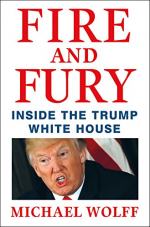|
This section contains 532 words (approx. 2 pages at 400 words per page) |

|
Fire and Fury: Inside the Trump White House Summary & Study Guide Description
Fire and Fury: Inside the Trump White House Summary & Study Guide includes comprehensive information and analysis to help you understand the book. This study guide contains the following sections:
This detailed literature summary also contains Topics for Discussion on Fire and Fury: Inside the Trump White House by Michael Wolff.
The following version of this book was used to create this study guide: Wolff. Michael. Fire and Fury: Inside the Trump White House. Henry Holt and Co, 2018.
Fire and Fury: Inside the Trump White House by Michael Wolff is contemporaneous account of the first six months of the Presidency of Donald Trump. It begins at the 2016 election and runs until August 2017 when John Kelly was chosen as Trump’s Chief of Staff. It relies heavily on sources within the White House, with whom Wolff had nearly unrestricted contact. It depicts the internal operation of the White House, Trump’s personal approach to the Presidency, and the background of several major decisions. Broadly, it shows a chaotic administration, governed by the President’s impulses and reaction to individual events and news coverage. Trump appears unable to institute a single guiding agenda and instead encourages his staff members to compete for influence, thus advancing their own views.
As late as the morning of election day in 2016, most people within the Trump campaign did not believe he was capable of winning the election. Staffers were already planning their future careers as media personalities and Republican operatives. Trump’s victory, therefore, was a significant shock, forcing the organization to respond quickly in setting up an administration. Because Trump lacked any coherent ideology of his own, various conservative actors tried to convince the President to adopt their agendas. No one was more successful at this than Steve Bannon, who secured a prominent place in the transition and early administration. Bannon espoused a hypernationalist agenda and worked to quickly undermine the traditional structures of government.
Upon taking office, Trump’s administration was dominated by infighting between Bannon, Trump’s son-in-law Jared Kushner, and Chief of Staff Reince Priebus, who represented traditional Republican doctrine. As the three men competed for influence, the Presidency largely lacked direction and accomplishments as was plagued by press leaks and the impulsive actions of the President himself. Wolff traces the cyclical rise and fall of these three over the course of several major events including the Obamacare repeal efforts and the response to the Syrian chemical weapons attack, and concluding with the firing of Priebus and Bannon in the summer of 2017.
Another major focus of Wolff’s work is the investigation into possible collusion between the Trump campaign and the Russian government to influence the 2016 election. Trump and his staff originally dismissed any allegations as the work of former Obama-era officials seeking to undermine Trump’s Presidency. A major turning point occured when Trump fired FBI director James Comey in an effort to end the investigation. This led to considerable backlash and the appointment of a Special Counsel to oversee the probe, increasing its threat to the Trump Presidency. At time of writing, the conclusion was still unknown.
Finally, Wolff devotes significant attention to Trump’s relationship with the media. Despite criticizing them frequently, Trump is obsessed with news organizations and their coverage of him. He is determined to receive positive coverage and relies on news outlets for the majority of his information. This has encouraged staff members to tailor their behavior significantly in order to encourage positive coverage of the President.
Read more from the Study Guide
|
This section contains 532 words (approx. 2 pages at 400 words per page) |

|



